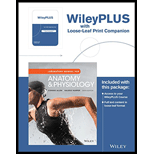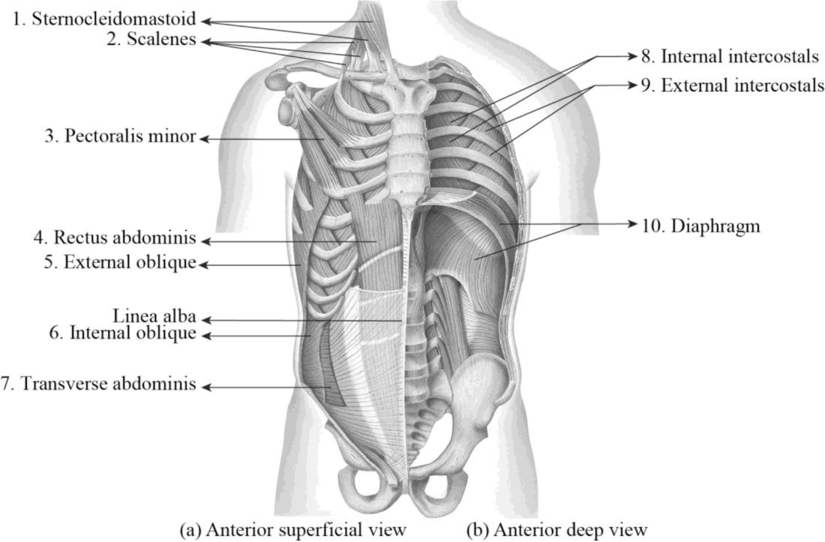
To label: The structures in Figure 33.1.
Introduction: The muscles that are involved in the process of breathing are referred to as the respiratory muscles. These muscles contribute to the inhalation and exhalation processes by aiding the contraction and expansion of the thoracic cavity. The diaphragm, internal and external intercostals, pectoralis minors, scalenes, sternocleidomastoids, and abdominal muscles are the primary muscles of the respiration.
Answer to Problem 1.1BGL
Pictorial representation:

Explanation of Solution
1. Sternocleidomastoid: A strap-like muscle that is situated on the lateral and the anterior portion of the neck is termed as the sternocleidomastoid. These muscles are involved in the respiration process by working along with the scalene muscles. These muscles are involved in raising the sternum during the forced inspiration while breathing.
2. Scalenes: A group of three pairs of muscles situated in the lateral region of the neck is referred to as the scalenes. The three pairs of these muscles include the anterior, middle, and posterior scalenes. The primary action of the scalene muscles is the elevation of the first and second ribs.
3. Pectoralis minor: The pectoralis minor is a flat, thin-shaped muscle located beneath the pectoralis major. This muscle elevates from the 3rd, 4th, and 5th ribs on each side of the rib cage. From these locations, the pectoralis minor muscle extends up to the chest and gets inserted into the coracoid process of the shoulder blade. The main function of this muscle is to expand the rib cage for aiding inhalation. This would help to expand the lungs and hold the breath for a long period of time.
4. Rectus abdominis: The rectus abdominis is a long strap muscle that begins at the pubic bone and ends at the sternum. They are the midline abdominal muscles that are situated between the inguinal ligament and the sternum. The main function of these muscles is flexion of the vertebral column and compression of the abdomen. It plays an essential role in respiration with exhalation during exercises.
5. External oblique: The external oblique muscles are the largest and outermost abdominal muscles. They are wide thin muscles that run diagonally downward each side of the abdomen. These muscles help to rotate the trunk. They pull the chest downward and compress the abdominal cavity.
6. Internal oblique: The internal oblique muscles are located beneath the external obliques. The fibers of these muscles run obliquely up toward the linea alba (band of the connective tissue, which runs up the midline of the abdomen). The main action of the internal obliques includes the flexion, lateral rotation, and lateral flexion of the trunk.
7. Transverse abdominis: The transverse abdominis is a muscle layer that is present in the anterior and lateral side of the abdominal wall. They are situated deep within the internal oblique muscles. This muscle is also termed as the transversus abdominis and transverse abdominal muscle (TVA). The main function of this muscle is to activate the core muscles and to stabilize the low back and pelvis prior to the body movement.
8. Internal intercostals: A group of 22 pairs of tiny skeletal muscles that are located in between the skeletal muscles are referred to as the internal intercostals. They play a vital role in the chest movement during the process of breathing. These muscles are involved in the process of forced exhalation by depressing the ribs.
9. External intercostals: A group of muscles that are located in between the outside of the ribs is referred to as the external intercostals. They play a vital role in the chest movement during the process of breathing. These muscles are involved in the process of forced and quiet inhalation of air. The primary action of these muscles is to elevation or raising and expansion of the ribs.
10. Diaphragm: A thin skeletal muscle that is situated at the base of the chest is referred to as a diaphragm. It separates the abdominal cavity from the chest. It plays a vital role in the process of respiration. It is involved in pulling the air into the lungs by creating a vacuum effect. During inhalation, the diaphragm is contracted and gets flattened. During exhalation, the diaphragm gets relaxed and pushes the air out of the lungs.
Want to see more full solutions like this?
Chapter 33 Solutions
Laboratory Manual for Anatomy and Physiology, 6e Loose-Leaf Print Companion
 Human Anatomy & Physiology (11th Edition)BiologyISBN:9780134580999Author:Elaine N. Marieb, Katja N. HoehnPublisher:PEARSON
Human Anatomy & Physiology (11th Edition)BiologyISBN:9780134580999Author:Elaine N. Marieb, Katja N. HoehnPublisher:PEARSON Biology 2eBiologyISBN:9781947172517Author:Matthew Douglas, Jung Choi, Mary Ann ClarkPublisher:OpenStax
Biology 2eBiologyISBN:9781947172517Author:Matthew Douglas, Jung Choi, Mary Ann ClarkPublisher:OpenStax Anatomy & PhysiologyBiologyISBN:9781259398629Author:McKinley, Michael P., O'loughlin, Valerie Dean, Bidle, Theresa StouterPublisher:Mcgraw Hill Education,
Anatomy & PhysiologyBiologyISBN:9781259398629Author:McKinley, Michael P., O'loughlin, Valerie Dean, Bidle, Theresa StouterPublisher:Mcgraw Hill Education, Molecular Biology of the Cell (Sixth Edition)BiologyISBN:9780815344322Author:Bruce Alberts, Alexander D. Johnson, Julian Lewis, David Morgan, Martin Raff, Keith Roberts, Peter WalterPublisher:W. W. Norton & Company
Molecular Biology of the Cell (Sixth Edition)BiologyISBN:9780815344322Author:Bruce Alberts, Alexander D. Johnson, Julian Lewis, David Morgan, Martin Raff, Keith Roberts, Peter WalterPublisher:W. W. Norton & Company Laboratory Manual For Human Anatomy & PhysiologyBiologyISBN:9781260159363Author:Martin, Terry R., Prentice-craver, CynthiaPublisher:McGraw-Hill Publishing Co.
Laboratory Manual For Human Anatomy & PhysiologyBiologyISBN:9781260159363Author:Martin, Terry R., Prentice-craver, CynthiaPublisher:McGraw-Hill Publishing Co. Inquiry Into Life (16th Edition)BiologyISBN:9781260231700Author:Sylvia S. Mader, Michael WindelspechtPublisher:McGraw Hill Education
Inquiry Into Life (16th Edition)BiologyISBN:9781260231700Author:Sylvia S. Mader, Michael WindelspechtPublisher:McGraw Hill Education





